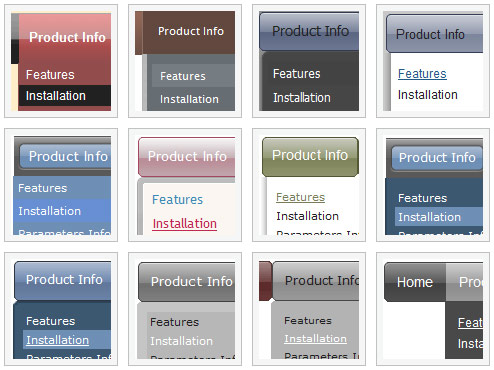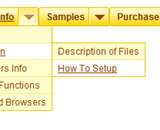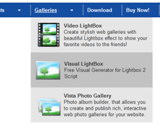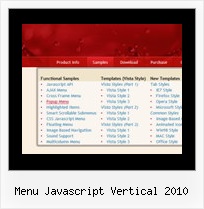Recent Questions
Q: Once I have an answer form your reseller as to why the VAT doesn't correspond with my country's rate, I think that there is a very strong possibility that I will be investing in this impressive menu-builder. I do have a couple of questions which don't seem to be answered anywhere:
1: is it possible to configure the menu so that the person browsing the site previously-visited javascript menu links can be identified by say using a different font colour for visited 'pages'?
2: the section of the web page in which the menu is located is called by a SSI for each new page that the browser visits - will the menu rest each time the Included file is called, or will it persist from page to page?
A: > 1: is it possible to configure the menu so that the person browsing> the site previously-visited javascript menu links can be identified by say using a > different font colour for visited 'pages'?
You can find more info here:
http://www.deluxe-menu.com/highlighted-items-sample.html
Deluxe Menu has only two states normal and mouseover.
Try to do the following things:
- delete var pressedItem=1; parameter from your data file
- set correct parameter on each page before you call data file, forexample:
<noscript><a href="http://deluxe-menu.com">Javascript Menu by Deluxe-Menu.com</a></noscript>
<script type="text/javascript"> var dmWorkPath = "menudir/";</script>
<script type="text/javascript" src="menudir/dmenu.js"></script>
<script type="text/javascript"> var pressedItem=3;</script>
...
<script type="text/javascript" src="menudir/data.js"></script>
You can also set a pressed item using Javascript API:
function dm_ext_setPressedItem (menuInd, submenuInd, itemInd, recursion)
Sets a current pressed item.
menuInd - index of a menu on a page, >= 0.
submenuInd - index of a submenu, >= 0.
itemInd - index of an item, >=0.
recursion = true/false - highlight parent items.
But notice, to use dm_ext_setPressedItem() you should know ID of selected item and subitem.
You can't get this ID after you reload your page. That is why you should write your own code on PHP.
See the attached example. Open deluxe-menu1.html. The first item ishighlighted. Then click to open deluxe-menu2.html file. The second item ishighlighted.
> 2: the section of the web page in which the menu is located is called> by a SSI for each new page that the browser visits - will the menu > rest each time the Included file is called, or will it persist from > page to page?
Deluxe Menu is the Javascript product. It means that it works on aclient side only and it doesn't depend on the server which you'reusing and it doesn't work on a server side as SSI script.
So when your browser reloads a page with the menu your menu reloads too.
Q: We have problems with the japanese down css menu being seen on many Japanese computers. It comes up with squares.
Can you advise us how we can fix that program.
A: If you are using a Japanese system then everything should render correctly.
If you are using an English system with a Japanese IME then you willneed to set the font in the Tuner to one that supports the characters you require.
Q: Is there a javascript function that I can call that will return the ID or the Text value of the currently active tab of the web navigation?
A: Unfortunately there is no such a function now.
There are such variables.
dtabs_tabs[menuN].b1 - dtabs_tabs[menuN].selectedItem
dtabs_tabs[menuN].JT0 - dtabs_tabs[menuN].selectedSmItem
But they contain the index of the selected menu item, not the ID.
Q: I have function "confirmLogout()" that it returns true or false. If it is false, the function does not make nothing. If it's true, I need to direct for the page "goout.jsp". How to use this function in the mouseover drop menu?
function confirmLogout() {
if(confirm('It really desires to leave? ?')) {
return true;
} else {
return false;
}
}
A: Actually you can use your own Javascript code instead standard mouseover drop menu links. For example:
var menuItems = [
["text", "javascript:your_code_here"]
];
or
var menuitems = [
["<div onClick='your_code_here'>item text</div>", ""]
];










